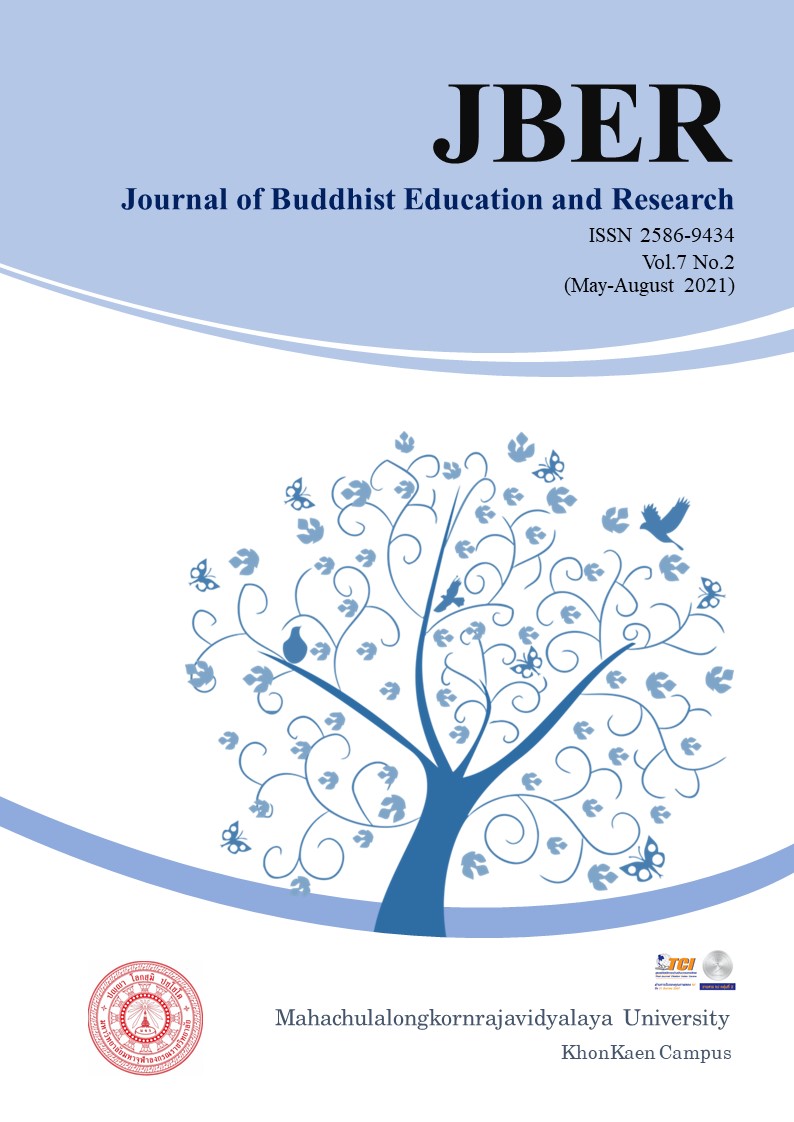BUDDHIST METHODS OF TEACHING SOCIAL STUDIES IN THE 21st CENTURY
Keywords:
Buddhism; Teaching Social Studies; 21st CenturyAbstract
Buddhism method of teaching, is a method that can be applied in the development of learners according to the era. The Buddha disseminated the dhamma that he had enlightened for the people of all groups to learn. The teaching of the Buddha there are four main characteristics: 1. Santasana, in his teaching and teaching, will explain to the audience clearly, clearly, and actually see it. 2. His body will explain to the audience that what is said That is the truth. 3. Samut Techana: He will use the method to stir up his audience. They are eager to follow that principle successfully and 4. Seminariness in lecturing Dharma He will create an atmosphere conducive to learning.
The world society in the 21st century has progressed in science and technology. Learning management is being done in a more interdisciplinary way. And integrate 21st century skills into all core subjects, such as world knowledge, knowledge of finance, economics, business and entrepreneurship, knowledge of good citizenship, health knowledge, environmental knowledge, etc. However, the Buddhist teaching method of the Buddha that had previously laid out the principles of teaching was still applied in order to achieve world-wise teaching and not abandon the Dhamma according to the Buddha's line. "Knowledge and Morality".
References
กระทรวงศึกษาธิการ. (2552). พระราชบัญญัติการศึกษาแห่งชาติ ฉบับที่ 2 พ.ศ. 2552. กรุงเทพฯ: โรงพิมพ์องค์การรับส่งสิ้นค้าและพัสดุภัณฑ์.
ปรเมธี วิมลศิริ. (2559). ยุทธศาสตร์ชาติ 20 ปี อนาคตประเทศไทย เพื่อความมั่นคง มั่งคั่ง ยั่งยืน. สืบค้นเมื่อ 12 กรกฎาคม 2563 จาก http://planning.pn.psu.ac.th/plan_doc/procedure/docs_
procedure/300_1498813858.pdf
ประเวศ วะสี. (2546). วิถีมนุษย์ในศตวรรษที่ 21 สู่ภพภูมิใหม่แห่งการพัฒนา. วารสารหมออนามัย. 12 (4), 7 21.
พระครูปลัดประกอบ ฐานวุฑโฒ (ศรอินทร์). (2558). การเรียนรู้ที่เป็นเลิศในศตวรรษที่ 21. วารสารครุศาสตร์ปริทรรศน์ฯ. 2(3), 59-60.
พระเทพเวที (ประยุทธ์ ปยุตฺโต), (ม.ป.ป.). ความสำคัญของพระพุทธศาสนาประจำชาติ. กรุงเทพฯ : ฝ่ายเผยแผ่พระพุทธศาสนา กองศาสนศึกษา กรมการศึกษา กระทรวงศึกษาธิการ.
______. (ม.ป.ป.). เทคนิคการสอนของพระพุทธศาสนา. กรุงเทพฯ: อมรินทร์ปริ้นกรุ๊ป.
พระธรรมปิฎก (ป.อ. ปยุตฺโต). (2544). พุทธวิธีในการสอน. (พิมพ์ครั้งที่ 8). กรุงเทพฯ : สหธรรมิก.
______. (2540). พระพุทธศาสนาพัฒนาคนและสังคม. กรุงเทพฯ : โรงพิมพ์ส่วนท้องถิ่น.
พระพรหมคุณาภรณ์ (ป.อ. ปยุตโต). (2539). วินัยเรื่องที่ใหญ่กว่าคิด. กรุงเทพฯ: โรงพิมพ์คุรุสภา.
วรวิทย์ วศินสรากร. (2546). คนกับการศึกษา. กรุงเทพฯ : ธนธัชการพิมพ์.
วศิน อินทสระ. (2545). พุทธวิธีการสอน. พิมพ์ครั้งที่ 5. กรุงเทพฯ : โรงพิมพ์เม็ดทราย.
______. (2563). ไตรลักษณ์. สืบค้นเมื่อ 1 พฤศจิกายน 2563. จาก http;//www.jozh.net/index.pho?mo=3 &art=2456056.
วิภาดา พินลา. (2559). กระบวนการจัดการเรียนรู้ตามแนวพุทธศาสตร์สำหรับครูสังคมศึกษาเพื่อปลูกฝังจริยธรรมในผู้เรียนยุคศตวรรษที่ 21. Veridian E-Journal, Silpakorn University. 9(1), 1434-1435.
สำเริง บุญเริงรัตน์. (2542). สติปัญญาและความถนัดทางการเรียนของมนุษย์ ทฤษฎี วิธีวัดและการพัฒนา. กรุงเทพฯ : มหาวิทยาลัยวงษ์ชวลิตกุล.
สุคนธ์ สินธพานนท์. (2558). การจัดการเรียนรู้ของครูยุคใหม่ เพื่อพัฒนาทักษะผู้เรียนในศตวรรษที่ 21.กรุงเทพฯ: ห้างหุ้นส่วนจากัด 9119 เทคนิคพพริ้นติ้ง.
สุมน อมรวิวัฒน์. (2547). การพัฒนาการเรียนรู้ตามแนวพุทธศาสตร์: ทักษะกระบวนการเผชิญสถานการณ์, (พิมพ์ครั้งที่ 3). กรุงเทพฯ: มหาวิทยาลัยสุโขทัยธรรมาธิราช.
แสง จันทร์งาม. (2524). การสอนจริยธรรมในโรงเรียนกรุงเทพมหานคร. กรุงเทพฯ: การศาสนา.
อภิชาตนันท์ อนันนับ, ภัคพงศ์ ปวงสุข และปิ่นมณี ขวัญเมือง. (2554). การนำหลักปรัชญาเศรษฐกิจพอเพียงมาใช้ในการจัดการเรียนการสอนวิชาเกษตรในโรงเรียนมัธยมศึกษา สังกัดสำนักงานเขตพื้นที่การศึกษากรุงเทพมหานคร เขต 3. วารสารครุศาสตร์อุตสาหกรรม. 11(1), 29-39.





